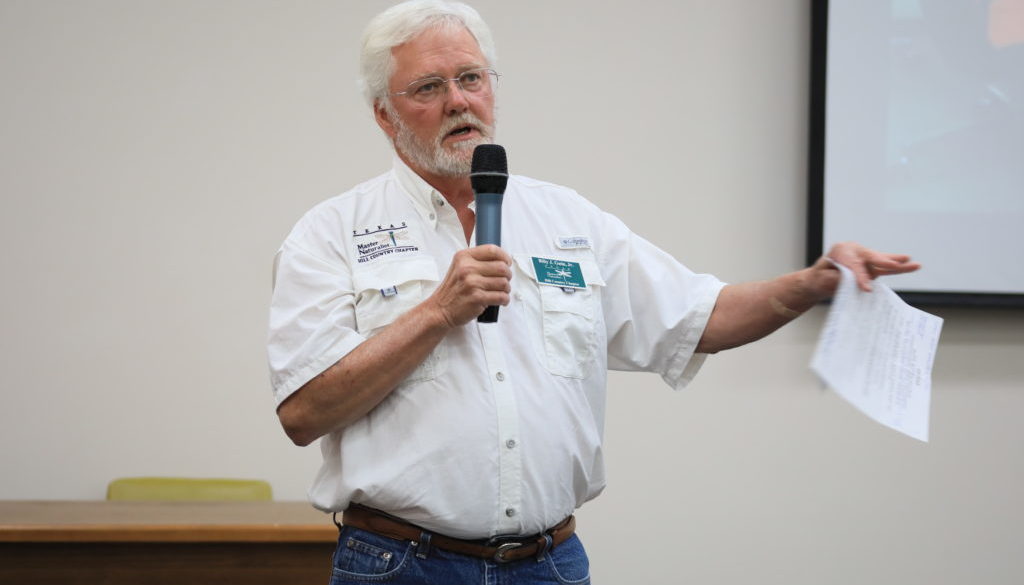In the aftermath of the Crabapple Wildfire that burned over 9,000 acres in Gillespie County, the local chapter of Texas Master Naturalists sponsored a talk aptly named “Fire! What to Do Before, During and After” featuring the chapter’s own Billy Guin.
“I never thought that I would be up here speaking about this subject and I hope that you are never in the same situation,” said Guin.
Guin and his wife, Patti, have a 20-acre property that fell in the path of the wildfire. A total of 18 acres got scorned by the flames, but the Guin’s home and around two acres surrounding it were spared.
“The Crabapple fire covered almost 10,000 acres. I believe nine or 10 residences were lost, numerous outbuildings, a huge amount of farm equipment … all are types of losses that occurred. The two acres right around our house, the shop, the well house and the cabin that we have did not burn. I credit that to Patti for mowing the grass short, three inches to four inches,” said Guin.
Guin emphasized how his wife’s upkeep of the lawn care made a massive difference in how much loss they experienced. The Guin’s residence surviving the wildfire was due to a combination of preparation before the incident and quick-thinking during the evacuation process.
“We have a gravel road that kind of circles about half of the buildings that we have on the property, so we’ve got that line of about eight feet of rock before you get to the house, which will protect it from embers,” said Guin.
Guin indicated that the type of landscaping most people are used to seeing around residential properties actually isn’t the safest for wildfire prevention.
“The way we typically have always landscaped our properties, especially in the city, is starting with high bushes and trees right next to the house, then you’ve got smaller bedding plants, shrubs, and bushes, and then you start your lawn. Well, everything they tell you is the opposite for fire protection,” said Guin.
To limit the damage potentially caused during a wildfire, Guin recommended keeping large plants and trees away from the home, and incorporating them into the yard at greater distances to reduce the likelihood of embers catching a plant on fire that then ignites the home.
“The TMN program has taught us to let everything grow, but it’s recommended to cut all the limbs up for about 10 feet, so there’s no fuel there to catch everything on fire. That’s just a personal choice as to what you want to do with your property, but just keep those things in mind when you’re preparing your property for fire protection,” said Guin.
During the wildfire, the Guin family had about an hour to do final preparations before evacuating to safety, during which Billy took a few extra measures to minimize loss.
“Right before we got out, I had the fortunate foresight to go and take a hose from our pump house and hook it up to an oscillating sprinkler. I put the sprinkler on our gas generator, the propane tank, and the electric service pole. When we came back, where that water line stopped, where the water was going, that’s where the fire stopped,” said Guin.
Guin also had the opportunity to move some of his equipment and vehicles to the opposite side of Highway 16, hoping the road would interrupt the fire’s path. For those in a more urgent evacuation, Guin gave additional advice.
“One thing you might want to do if you don’t have time to get your equipment out into a roadway away from flames is to park it at the end of your driveway, not close to the house. If it does catch fire, it’s got gasoline in it or diesel which could be another fire fuel source,” said Guin.
As for Guin’s firsthand experience of the aftermath of the fire, he shares a few tips for the future.
“After the fire I went around and looked to see what I should have done that I didn’t do. I saw that we’ve got a lot of flammable stuff under our shed, and a bunch of leaves that had blown under that could’ve easily sparked. Since then, I have cleaned out the area and used a leaf blower to get all of that out from the base of the shed. I also put a caliche and river-rock pad around the propane tank and generator to keep the grass from growing next to those,” said Guin.
Wildfires, especially one as vast as the Crabapple Fire, are a devastating reality for many Texans, with more than 500 wildfires burning over 100,000 acres just in March of this year. The Hill Country chapter of Texas Master Naturalists encouraged homeowners to be proactive in their fire-safety by inviting the public to attend their informative presentation.
For more information about the Texas Master Naturalists, visit www.txmn.org/hillcountry.
